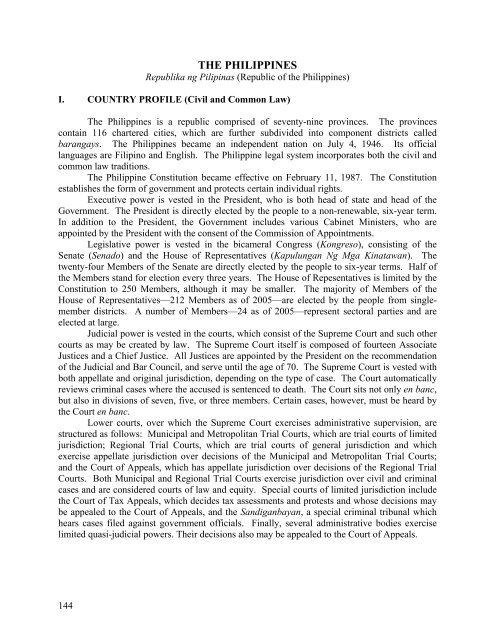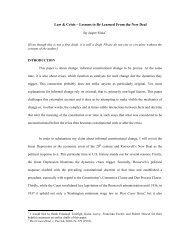Guide to Foreign and International Legal Citations - New York ...
Guide to Foreign and International Legal Citations - New York ...
Guide to Foreign and International Legal Citations - New York ...
Create successful ePaper yourself
Turn your PDF publications into a flip-book with our unique Google optimized e-Paper software.
144<br />
THE PHILIPPINES<br />
Republika ng Pilipinas (Republic of the Philippines)<br />
I. COUNTRY PROFILE (Civil <strong>and</strong> Common Law)<br />
The Philippines is a republic comprised of seventy-nine provinces. The provinces<br />
contain 116 chartered cities, which are further subdivided in<strong>to</strong> component districts called<br />
barangays. The Philippines became an independent nation on July 4, 1946. Its official<br />
languages are Filipino <strong>and</strong> English. The Philippine legal system incorporates both the civil <strong>and</strong><br />
common law traditions.<br />
The Philippine Constitution became effective on February 11, 1987. The Constitution<br />
establishes the form of government <strong>and</strong> protects certain individual rights.<br />
Executive power is vested in the President, who is both head of state <strong>and</strong> head of the<br />
Government. The President is directly elected by the people <strong>to</strong> a non-renewable, six-year term.<br />
In addition <strong>to</strong> the President, the Government includes various Cabinet Ministers, who are<br />
appointed by the President with the consent of the Commission of Appointments.<br />
Legislative power is vested in the bicameral Congress (Kongreso), consisting of the<br />
Senate (Senado) <strong>and</strong> the House of Representatives (Kapulungan Ng Mga Kinatawan). The<br />
twenty-four Members of the Senate are directly elected by the people <strong>to</strong> six-year terms. Half of<br />
the Members st<strong>and</strong> for election every three years. The House of Repesentatives is limited by the<br />
Constitution <strong>to</strong> 250 Members, although it may be smaller. The majority of Members of the<br />
House of Representatives—212 Members as of 2005—are elected by the people from singlemember<br />
districts. A number of Members—24 as of 2005—represent sec<strong>to</strong>ral parties <strong>and</strong> are<br />
elected at large.<br />
Judicial power is vested in the courts, which consist of the Supreme Court <strong>and</strong> such other<br />
courts as may be created by law. The Supreme Court itself is composed of fourteen Associate<br />
Justices <strong>and</strong> a Chief Justice. All Justices are appointed by the President on the recommendation<br />
of the Judicial <strong>and</strong> Bar Council, <strong>and</strong> serve until the age of 70. The Supreme Court is vested with<br />
both appellate <strong>and</strong> original jurisdiction, depending on the type of case. The Court au<strong>to</strong>matically<br />
reviews criminal cases where the accused is sentenced <strong>to</strong> death. The Court sits not only en banc,<br />
but also in divisions of seven, five, or three members. Certain cases, however, must be heard by<br />
the Court en banc.<br />
Lower courts, over which the Supreme Court exercises administrative supervision, are<br />
structured as follows: Municipal <strong>and</strong> Metropolitan Trial Courts, which are trial courts of limited<br />
jurisdiction; Regional Trial Courts, which are trial courts of general jurisdiction <strong>and</strong> which<br />
exercise appellate jurisdiction over decisions of the Municipal <strong>and</strong> Metropolitan Trial Courts;<br />
<strong>and</strong> the Court of Appeals, which has appellate jurisdiction over decisions of the Regional Trial<br />
Courts. Both Municipal <strong>and</strong> Regional Trial Courts exercise jurisdiction over civil <strong>and</strong> criminal<br />
cases <strong>and</strong> are considered courts of law <strong>and</strong> equity. Special courts of limited jurisdiction include<br />
the Court of Tax Appeals, which decides tax assessments <strong>and</strong> protests <strong>and</strong> whose decisions may<br />
be appealed <strong>to</strong> the Court of Appeals, <strong>and</strong> the S<strong>and</strong>iganbayan, a special criminal tribunal which<br />
hears cases filed against government officials. Finally, several administrative bodies exercise<br />
limited quasi-judicial powers. Their decisions also may be appealed <strong>to</strong> the Court of Appeals.
















